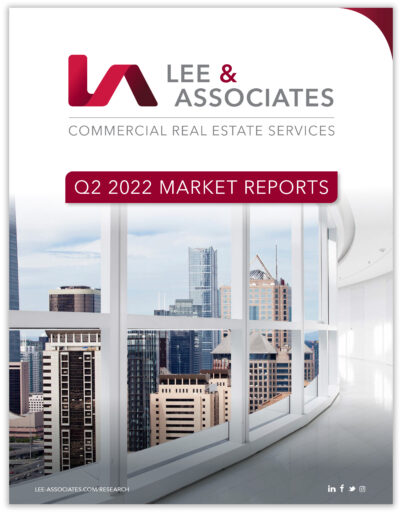INDUSTRIAL OVERVIEW: RECORD LOW SUPPLY, RENT GROWTH
Demand for industrial space eased slightly from its record-setting growth of last year but remained strong through for the first half of 2022 as annualized rent growth moved into double digits and the overall vacancy rate fell to 3.9%, a record low. Net absorption through June totaled 192.2 million SF. It was the second highest two-quarter total on record and more than the 170 million SF of tenant growth for all of 2019. It was exceeded only by 297.8 million SF of net absorption in the second half of last year.
The Canadian market also is tight. At the end of Q2 the vacancy rate was 1.4%. Net absorption in the first half totaled 9.2 million SF. Annual rent growth was 12.4% nationally and 15.4% in the Toronto market, the nation’s largest, and 13% in Vancouver.
Since early last year, quarterly net absorption in the U.S. market has averaged 53% or more than in all the years before the pandemic. Net absorption in 2021 totaled 515.8 million SF. That’s 57% more than in 2020, the year of the lockdown and before e-commerce could fully ramp up to meet sudden demand. Nevertheless, measurements show that with lower hospitalization rates, in-person shopping in 2021 gained ground on e-commerce, perhaps for the first time. The shift was affirmed with Amazon’s recent announcement that it is slowing expansion of its distribution network. The news prompted one tech columnist to write consumers have moved on from the lockdown’s “e-commerce craze to malaise.” But U.S. households accrued an extra $5 trillion during the pandemic – savings that will help consumers weather a downturn or further erosion of spending power due to inflation. READ MORE >
OFFICE OVERVIEW: DEMAND FALLS; VACANCIES, SUBLETS CLIMB
Demand for North American office space weakened in the second quarter with net absorption slipping into negative territory and vacancies hitting their highest levels in a decade as companies continue to assess workplace schedules and real estate needs. Although the 8.3-billion-SF U.S. market closed out the second half of 2021 with a strong 27 million SF of positive net absorption, demand went flat in January. Tenants shed 1.5 million SF of space in the first half with 992,701 SF of negative absorption coming in Q2. The overall vacancy rate settled at 12.4%.
Across Canada, leasing volumes are below their long-term averages heading into the summer. Demand is strongest in Vancouver and other West Coast cities. About 3 million SF under construction in each Toronto and Vancouver are set for completion by 2024. Approximately 75% of the space is preleased.
After stabilizing in the second half of 2021, sublease availability in the U.S. has moved higher, setting a record at 214 million SF. Available second-hand space is up more than 50% in Salt Lake City, more than 40% in Cincinnati and more than 30% in Tampa, Minneapolis, San Antonio and Orange County, California. In San Francisco, sublease inventory totals more than 9.6 million SF, more than half of which still is occupied, representing 2.5% of inventory, double the national average. READ MORE >
RETAIL OVERVIEW: BRICK-AND-MORTAR GAINS ON E-COMMERCE
In-person shopping is regaining its popularity and it’s taking a toll on e-commerce. Merchant demand for retail space in the United States is the most since 2017 with net absorption on track to expand by nearly 80 million SF in 2022. The overall vacancy rate has fallen 60 basis points over the last two quarters, settling at 4.4%, the lowest on record.
Canadian demand for retail space also strengthened in the first half of 2022. The 3.8 million SF of net absorption through Q2 equals total demand for 2020 and is on pace to match the average annual growth of the previous five years. The tightest markets are Vancouver and Toronto, whose vacancy rates are 1.2% and 1.7% respectively. The two metros also have the nation’s highest rents.
Leading the forces behind tenant growth is a financially healthy and active consumer. Last year in-person shopping gained ground on e-commerce, possibly a first. An analysis by Mastercard says U.S. online purchases fell in March for the first time in a decade, adding more support to the view that online shopping has hit a wall, at least for now. The ripple effects are punishing the tech industry now to a similar degree that it was rewarded when the lockdown caused consumers to race ahead in their embrace of online shopping. READ MORE >
MULTIFAMILY OVERVIEW: RENTERS STYMIED BY HIGH HOME PRICES
The unprecedented pace of rent growth eased slightly in the first half of 2022 as strong demand continued for an undersupply of housing. However, to the relief of many U.S. renters, about 180,000 new apartments – roughly double the quarterly average – are slated for delivery in the third quarter and completions are expected to remain elevated through 2023. The steadily rising cost of home buying has been keeping people in the rental market longer. Mortgage rates are up, and existing home prices reached a record median $407,600 in May. Due to supply-chain disruptions and lengthening construction timelines, deliveries of new apartments have been flat. The U.S. vacancy rate settled at 4.9% at the end of the second quarter. In Canada, the vacancy rate was 1.9%.
There were 141,794 apartments absorbed in the U.S. in the first half of the year with 166,054 new units delivered. There are a record 745,000 units under construction. With projected deliveries this year at 453,410 and net absorption expected at 368,500 units, some estimates have rent growth slowing to less than 7% by the end of 2022.
The apartment market has never seen such widespread, double-digit rent growth. Only the run-up during the dot-com boom in tech centers like Boston and San Jose offers a comparison. Although rent growth moderated slightly, falling from 11.3% at the end of 2021 to 9.2% at the end of Q2, some Sun Belt markets have seen annual rent increases of more than 20%. Rents for single-family homes in April rose 14% year over year. Of the 50 largest U.S. multifamily markets only Phoenix and Sacramento have full-year rent forecasts below their five-year pre-pandemic average. READ MORE >




